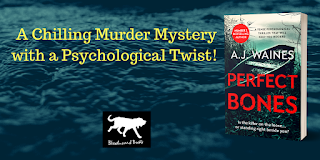I can honestly say that when it comes to personal experience of the
‘criminal mind’, fact, for me, is just as chilling as fiction. That’s because before I became an author, I'd been a
psychotherapist for fifteen years, working from time to time in a safe-house
for ex-offenders. The residents were from high-security institutions; women who
had served sentences for arson, stabbings, suffocating and all manner of fatal
attacks.
So, how has my writing been influenced by working at the
safe-house?
Surprisingly,
I came away from my encounters with these women feeling more sad, than
disturbed. The women had grown up with stabbings, shootings and muggings; they
knew no other kind of life. Most had a fragile personality-type, were easily
led and got involved with criminal activity because their
brothers/sister/mothers lived that life too. Often anti-establishment, they
were seeking leadership, gang-culture, excitement and risk-taking. More often
than not, they were simply looking for a sense of “family” and belonging.
Since working in the safe-house, I’m
inclined to cast women rather than men as the culprits in my books, but they’re
never ‘monsters’. While I write about killers and serial killers, they aren’t
thugs or callous maniacs. There’s very little violence and gore in my books and
far more about harrowing mind-games and dark, driven motives behind the radical
acts involved. I’m also fascinated by the differences between law-abiding
citizens and those who cross the line into serious crime. I love writing about characters' inner struggle for
revenge, their tortured reasons for keeping secrets and telling lies! As a result of all
this, I hope my books show a good degree of humanity.
How ‘safe’ was it?
The
‘safe-house’ wasn’t necessarily safe for everyone. During one of my visits, a
woman set fire to her room and others self-harmed, as cooking knives and
personal property was available as part of the rehabilitation process. Most
residents were on antipsychotic medication or drugs for anxiety or depression,
so mood-swings was an issue.
The
location and confidentiality was very strict, as you can imagine – a place for
the women to re-adjust to the idea of integrating back into society. I was
there to offer a listening ear for personal problems and fears of going back
‘outside’. Spending time in that volatile setting was tough, but it gave
me lots of raw material to slip into my novels!
In Perfect Bones, the sole witness to a gruesome attack – a teenage artist living on a narrowboat – is traumatised and can't utter a word. That’s when gutsy protagonist, psychologist Samantha Willerby, is given seven days by the police to coax information from him about the killer. When he finally makes a sketch, it's not what anyone expects – but by then another murder has been committed...
One of the techniques I used in the
safe-house was art therapy and in the novel this method is used for the mute witness. The reader has to watch and wait for the artist to show what he saw.
I was deeply affected by the
individuals I met in the safe-house and still wonder what happened to them and how their lives
turned out. Did they re-offend and end up back inside? Did they turn their
lives around? As an author, I like to pose the question ‘how would you react in this tricky situation?’
just as, when I think of those women, I wonder how I would have turned out if I’d had their dysfunctional backgrounds,
violent environment and deprivation to cope with.
Perfect Bones is available at all Amazon outlets.
This interview was first published on the Crime Readers' Association website.
~~~~~~~~~~~~~~~~~~~~~~~~~~


